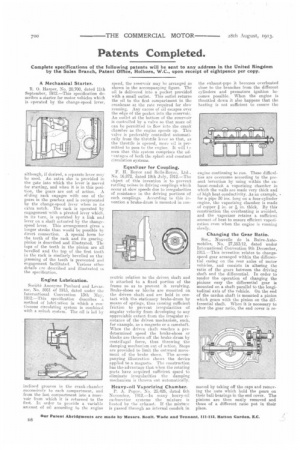Patents Completed.
Page 24

If you've noticed an error in this article please click here to report it so we can fix it.
Complete specifications of the following patents will he sent to any address in the United Kingdom by the Sales Branch, Patent Office, Holborn, W.C., upon receipt of eightpence per copy.
A Mechanical Starter.
R. 0. Harper, No. 20,700, dated 11th September, 1912.—This specification describes a starter for motor vehicles which is operated by the change-speed lever,
although, if desired, a separate lever may be used. An extra slot is provided in the gate into which the lever is moved for starting, and when it is in this position, the gears are out of action. A sl1ding rack engages with one of the gears in the gearbox and is reciprocated by the change-speed lever when in its extra notch. The rack is operated by engagement with a pivoted lever which, in its turn, is operated by a link and lever on a shaft actuated by the changespeed lever. This arrangement gives a longer stroke than would be possible by direct connection. A special form for the teeth of the rack and its gearingpinion is described and illustrated. The tops of the teeth in the pinion are all bevelled and the top of the first tooth in the rack is similarly bevelled so that jamming of the teeth is prevented and engagement facilitated. Various other details r re described and illustrated in the specification.
Engine Lubrication.
Soci6tié, Anonyme Panhard and Levassor, No. 5951 of 1913, dated under the International Convention 13th 3lay, 1912.—This specification describes a method of lubrisation in which a continuous circulating system is combined with a s'dash system. The oil is led by inclined grooves in the crank.-ehamle successively to each compartment, and from the last compartment into a reservoir from which it is returned to the first. In order to provide a variable amcunt of oil according to the engine
speed, the reservoir may he arranged as shown in the accompanying figure. The oil is delivered into a pocket provided with a small outlet. This outlet returns the oil to the first compartment in the crankcase at the rate required for slow running. Any excess of oil escapes over the edge of the pocket into the reservoic. An outlet at the bottom of the reservoir is controlled by a valve so that more oil earl be permitted to flow into the crank chamber as the engine speeds up. This valve is preferably controlled automatically from the throttle lever so that, ilS the throttle is opened, more oil is permitted to pass to the engine. It will 1,seen that this system comprises the ad vantages of both the splash and constant circulation systems.
Equalizer for Coupling.
F. H. Royce and Rolls-Royce, Ltd., No. 16,872, dated 19th July, 1912.—The object of this invention is to prevent rattling noises in driving couplings which occur at slow speeds due to irregularities of resistance in the driving portions of such couplings. According to this invention a brake-drum is mounted in con
centric relation to the driven shaft and is attached to a fixed portion of the frame so as to prevent it revolving. Brake-shoes or blocks are mounted on the driven shaft arid are held in contact with the stationary brake-drum by means of springs, thus causing sufficient friction to prevent irregularities of angular velocity from developing to any appreciable extent from the irregular resistance of the driven mechanism, such, for example, as a magneto or a camshaft. When the driven shaft reaches a predetermined speed the brake-shoes or blocks are thrown off the brake-drum by centrifugal force, thus throwing the damping mechanism out of action. Stops are provided to limit the outward movement of the brake shoes. The accompanying illustration shows the device applied to a magneto. The construction has the advantage that when the rotating parts have acquired sufficient speed to eliminate irregularities the damping mechanism is thrown out automatically.
Heavy-oil Vaporizing Chamber, P. A. Poppe. No. 25,426, dated 6th November, 1912.—In many heavy-oil carburetter systems the mixture is I eked by the eshaust. If the mixture is passed through an internal conduit in the exhaust-pipe it becomes overheated close to the branches from the different cylinders and premature ignition becomes possible. When the engine is throttled dcwn it also happens that the heating is not sufficient to ensure the
ent.,ino continuing to run. These difficulties are overcome according to the present invention by using within the exhaust-conduit a vaporizing chamber in which the walls are made very thick and of high heat conductivity. As an example, . for a pipe 30 ins, long on a four-cylinder engine, the vaporizing chamber is made of copper in. or 156 in. thick. By this construction the overheating is avoided, and the vaporizer retains a sufficient amount of heat to ensure efficient vaporization even when the engine is running slowly.
Changing the Gear Ratio.
Soc., Nouvelle de la Buire-Automobiles, No. 27,553/12, dated under International Convention 9th December, 1911.—This invention relates to change. speed gear arranged within the differential casing on the rear axles of motor vehicles, and consists in altering the ratio of the gears between the driving shaft and the differential. In order to render the operation of changing the pinions easy the differential gear is mounted on a shaft parallel to the longitudinal axis of the vehicle. On the end of the cardan shaft is mounted a pinion which gears with the pinion on the differential shaft. When it is necessary to alter the gear ratio, the end cover is re
moved by taking off the caps and removing the nuts which hold the gears on their ball-bearings in the end cover. The pinions are then easily removed and those of a different ratio put in their place.
























